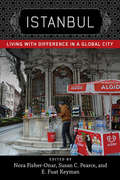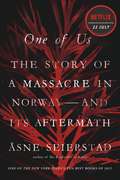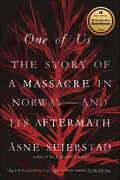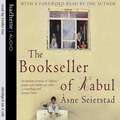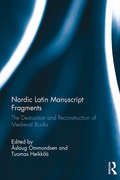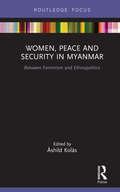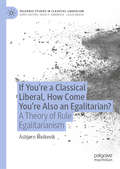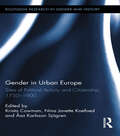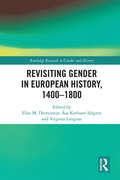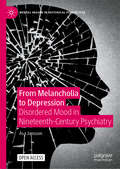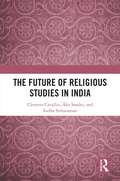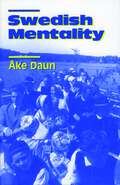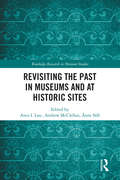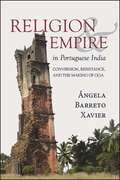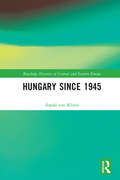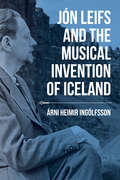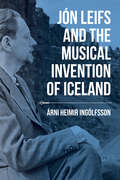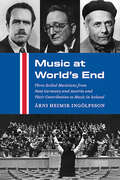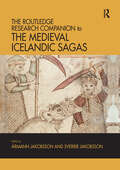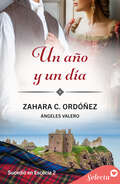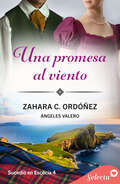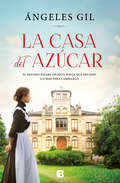- Table View
- List View
Istanbul: Living With Difference In A Global City (New Directions In International Studies)
by Charles King Susan C. Pearce E. Fuat Keyman Amy Mills Nora Fisher-Onar Çaglar Keyder Sami Zubaida Feyzi Baban Ilay Romain Örs Anna Bigelow Kristen Sarah Biehl Hande PakerIstanbul explores how to live with difference through the prism of an age-old, cutting-edge city whose people have long confronted the challenge of sharing space with the Other. Located at the intersection of trade networks connecting Europe, Asia, and Africa, Istanbul is western and eastern, northern and southern, religious and secular. Heir of ancient empires, Istanbul is the premier city of a proud nation-state even as it has become a global city of multinational corporations, NGOs, and capital flows. Rather than exploring Istanbul as one place at one time, the contributors to this volume focus on the city’s experience of migration and globalization over the last two centuries. Asking what Istanbul teaches us about living with people whose hopes jostle with one’s own, contributors explore the rise, collapse, and fragile rebirth of cosmopolitan conviviality in a once and future world city. The result is a cogent, interdisciplinary exchange about an urban space that is microcosmic of dilemmas of diversity across time and space.
One of Us: The Story of Anders Breivik and the Massacre in Norway
by Sarah Death Åsne SeierstadOn July 22, 2011, Anders Behring Breivik detonated a bomb outside the Norwegian prime minister's office in central Oslo, killing eight people. He then proceeded to a youth camp on the wooded island of Utøya, where he killed sixty-nine more, most of them teenage members of the country's governing Labour Party. One of Us tells the story of this terrible day and its reverberations. Åsne Seierstad delves deep into Breivik's childhood, tracing the unlikely path that led him to become one of Europe's most reviled terrorists, and writes with equal intimacy about his victims. One of Us is at once a psychological study of violent extremism, a dramatic true crime procedural, and a compassionate inquiry into how a privileged society copes with homegrown evil. This is the true story of one of our age's most tragic events. Named "ONE OF THE BEST BOOKS OF THE YEAR" (2015) by THE NEW YORK TIMES'S BOOK REVIEW, NPR, THE BOSTON GLOBE, THE GUARDIAN, BUZZFEEED, PUBLISHERS WEEKLY, AND MEN'S JOURNAL. This book has also been made into the movie "22 July."
One of Us: The Story of a Massacre in Norway—and Its Aftermath
by Åsne SeierstadA New York Times bestseller and the basis for the Netflix film 22 July: “A chilling descent into the mind of mass murderer Anders Breivik.” —Kirkus ReviewsOne of The New York Times Book Review’s Ten Best Books of 2015On July 22, 2011, Anders Behring Breivik detonated a bomb outside the Norwegian prime minister’s office in central Oslo, killing eight people. He then proceeded to a youth camp on the wooded island of Utøya, where he killed sixty-nine more, most of them teenage members of the country’s governing Labour Party. In One of Us, the journalist Åsne Seierstad tells the story of this terrible day and its reverberations. How did Breivik, a gifted child from an affluent neighborhood in Oslo, become Europe’s most reviled terrorist? How did he accomplish an astonishing one-man murder spree? And how did a famously peaceful and prosperous country cope with the slaughter of so many of its young?Delving deep into Breivik’s childhood, Seierstad shows how a hip-hop and graffiti aficionado became a right-wing activist, a successful entrepreneur, and then an Internet game addict and self-styled master warrior who believed he could save Europe from the threat of Islam and multiculturalism. She writes with equal intimacy about Breivik’s victims, tracing their political awakenings, teenage flirtations and hopes, and ill-fated journeys to the island. In the book’s final act, Seierstad describes Breivik’s tumultuous public trial.Lauded in Scandinavia for its literary merit and moral poise, One of Us is at once a psychological study of violent extremism, a dramatic true crime procedural, and a compassionate inquiry into how a privileged society copes with homegrown evil.
The Bookseller Of Kabul: The International Bestseller - 'An intimate portrait of Afghani people quite unlike any other' SUNDAY TIMES
by Åsne SeierstadFor more than twenty years Sultan Khan defied the authorities to supply books to the people of Kabul. He was arrested, interrogated and imprisoned, and watched illiterate soldiers burn piles of his books in the street.In spring 2002 award-winning journalist Åsne Seierstad spent four months living with the bookseller and his family. As she steps back from the page and lets the Khans tell their stories, we learn of proposals and marriages, hope and fear, crime and punishment. The result is a unique portrait of a family and a country.'A remarkable portrait, with deftly woven accounts of weddings and journeys, books and bookselling, relations and squabbles, firmly anchored by pleasing details about food and customs, all set against the backdrop of a derelict city, filthy and crammed but not defeated ... [Seierstad] was fascinated by everything she witnessed, and her curiosity and perceptive eye colours every page' INDEPENDENT
Nordic Latin Manuscript Fragments: The Destruction and Reconstruction of Medieval Books
by Åslaug Ommundsen Tuomas HeikkiläMuch of what is known about the past often rests upon the chance survival of objects and texts. Nowhere is this better illustrated than in the fragments of medieval manuscripts re-used as bookbindings in the sixteenth and seventeenth centuries. Such fragments provide a tantalizing, yet often problematic glimpse into the manuscript culture of the Middle Ages. Exploring the opportunities and difficulties such documents provide, this volume concentrates on the c. 50,000 fragments of medieval Latin manuscripts stored in archives across the five Nordic countries of Denmark, Finland, Iceland, Norway and Sweden. This large collection of fragments (mostly from liturgical works) provides rich evidence about European Latin book culture, both in general and in specific relation to the far north of Europe, one of the last areas of Europe to be converted to Christianity. <P><P>As the essays in this volume reveal, individual and groups of fragments can play a key role in increasing and advancing knowledge about the acquisition and production of medieval books, and in helping to distinguish locally made books from imported ones. Taking an imaginative approach to the source material, the volume goes beyond a strictly medieval context to integrate early modern perspectives that help illuminate the pattern of survival and loss of Latin manuscripts through post-Reformation practices concerning reuse of parchment. In so doing it demonstrates how the use of what might at first appear to be unpromising source material can offer unexpected and rewarding insights into diverse areas of European history and the history of the medieval book.
Women, Peace and Security in Myanmar: Between Feminism and Ethnopolitics
by Åshild KolåsThis book describes women’s efforts as agents for change in Myanmar and examines the potential of the peace process as an opportunity for women’s empowerment. Following decades of political turbulence, the volume describes the contributions of women in Myanmar in the midst of a difficult peace process and reflects on the significance of the Women, Peace and Security agenda in this context. The book examines how women have mobilized for peace, while also addressing women’s participation in the conflict, and investigates the perspectives and aims of women’s organizations and the challenges and aspirations of women activists in Myanmar’s ethnic areas. Contributions in the volume discuss and critically assess the argument that war and peacebuilding add momentum to the transformation of gender roles. By presenting new knowledge on women’s disempowerment and empowerment in conflict, and their participation in peacebuilding, this book adds important insights into the debate on gender and political change in societies affected by conflict. This book will be of interest to students of peace and conflict studies, gender studies and security studies in general.
If You’re a Classical Liberal, How Come You’re Also an Egalitarian?: A Theory of Rule Egalitarianism (Palgrave Studies in Classical Liberalism)
by Åsbjørn MelkevikClassical liberalism has wrongly been regarded as an ideology that rejects the welfare state. In this book, Åsbjørn Melkevik corrects this common reading of the classical liberal tradition by introducing a theory of “rule egalitarianism”. Not only is classical liberalism compatible with social justice, but it can also help us understand why some egalitarian endeavours are an essential feature of a market society. If a necessary link exists between the classical liberal tradition and the moral and institutional dimensions of the rule of law, then this tradition is bound to uphold a substantial form of social justice. Coherence requires that classical liberals like Friedrich Hayek and Milton Friedman adopt an authentic egalitarian program. They should ameliorate poverty and limit inequality not merely out of prudence or collective self-interest, but for the natural justice of ongoing social cooperation as well as for the impartiality of market institutions.
Gender in Urban Europe: Sites of Political Activity and Citizenship, 1750-1900 (Routledge Research in Gender and History #19)
by Krista Cowman Åsa Karlsson Sjögren Nina Javette KoefoedThis volume offers an integrated set of local studies exploring the gendering of political activities across a variety of sites ranging from print culture, courts, government and philanthropic bodies and public spaces, outlining how a particular activity was constituted as political and exploring how this contributed to a gendered concept of citizenship. The comparative and transnational perspectives revealed through combining such work contributes to establishing new knowledge about the relationship between gender, citizenship and the development of the modern town in Northern Europe.
Revisiting Gender in European History, 1400–1800 (Routledge Research in Gender and History #31)
by Virginia Langum Elise M. Dermineur Åsa Karlsson SjögrenDo women have a history? Did women have a renaissance? These were provocative questions when they were raised in the heyday of women’s studies in the 1970s. But how relevant does gender remain to premodern history in the twenty-first century? This book considers this question in eight new case studies that span the European continent from 1400 to 1800. An introductory essay examines the category of gender in historiography and specifically within premodern historiography, as well as the issue of source material for historians of the period. The eight individual essays seek to examine gender in relation to emerging fields and theoretical considerations, as well as how premodern history contributes to traditional concepts and theories within women’s and gender studies, such as patriarchy.
From Melancholia to Depression: Disordered Mood in Nineteenth-Century Psychiatry (Mental Health in Historical Perspective)
by Åsa JanssonThis open access book maps a crucial but neglected chapter in the history of psychiatry: how was melancholia transformed in the nineteenth century from traditional melancholy madness into a modern biomedical mood disorder, paving the way for the emergence of clinical depression as a psychiatric illness in the twentieth century? At a time when the prevalence of mood disorders and antidepressant consumption are at an all-time high, the need for a comprehensive historical understanding of how modern depressive illness came into being has never been more urgent. This book addresses a significant gap in existing scholarly literature on melancholia, depression, and mood disorders by offering a contextualised and critical perspective on the history of melancholia in the first decades of psychiatry, from the 1830s until the turn of the twentieth century.
The Future of Religious Studies in India
by Clemens Cavallin Åke Sander Sudha SitharamanThis book looks at how religious studies is framed and taught in India. It addresses the contradiction between the country’s vibrant religious life and the dearth of comparative and social scientific religious studies programs across Indian universities. The volume: • Studies the efforts by Rabindranath Tagore in Santiniketan and Mohan Malaviya in Varanasi, to introduce and institutionalize religious studies in India; • Discusses the notions of religion and spirituality and situates the failure of the ‘secularization thesis’ in the context of modern India; • Provides concrete suggestions on how to develop religious studies in relation to global citizenship and Indian cultural heritage with the hope of initiating a larger discussion. A unique contribution to the study of religion in society and education, the book will be indispensable to students and researchers of theology, history, philosophy, sociology, secularization, globalization, religious studies, education studies, and South Asian studies.
Swedish Mentality
by Åke DaunIs there a distinctly Swedish national character? Are Swedes truly shy, unemotional, conflict-avoiding, melancholy, and dour? Swedish Mentality, the English translation of the hugely successful book published in Sweden in 1989, considers the reality behind the myth. The author, Åke Daun, is a respected ethnologist who is sometimes referred to as the "guru" of Swedish character. In recent years, it has become popular to discuss Swedishness and Swedish identity. The advent of the European Union and the increasing presence of immigrant refugees in Sweden have fueled public debate on the distinctiveness of Swedish culture. Daun, however, goes beyond stereotype, drawing upon statistics gathered over more than a decade of research. The result is an entertaining and engagingly written book. Throughout, Daun quotes from interviews with native Swedes and immigrants as well as from travel accounts, folklore, and proverbs. We learn why some Swedes might prefer to walk up a flight of stairs rather than share an elevator with a neighbor and why some gain satisfaction from walking alone in the woods or going fishing. Daun describes a range of factors influencing Swedish character, including population composition, rural background, and even climate. He recognizes behavioral variations related to gender, age, class, and region, and he considers subtleties of individual character as well.Swedish Mentality should interest a wide array of readers, whether of Swedish descent or not.
Revisiting the Past in Museums and at Historic Sites (Routledge Research in Museum Studies)
by Anca I. Lasc Andrew McClellan Änne SöllRevisiting the Past in Museums and at Historic Sites demonstrates that museums and historic spaces are increasingly becoming "backdrops" for all sorts of appropriations and interventions that throw new light upon the objects they comprise and the pasts they reference. Rooted in new scholarship that expands established notions of art installations, museums, period rooms, and historic sites, the book brings together contributions from scholars from intersecting disciplines. Arguing that we are witnessing a paradigm shift concerning the place of historic spaces and museums in the contemporary imaginary, the volume shows that such institutions are merging traditional scholarly activities tied to historical representation and inquiry with novel modes of display and interpretation, drawing them closer to the world of entertainment and interactive consumption. Case studies analyze how a range of interventions impact historic spaces and conceptions of the past they generate. The book concludes that museums and historic sites are reinventing themselves in order to remain meaningful and to play a role in societies aspiring to be more inclusive and open to historical and cultural debate. Revisiting the Past in Museums and at Historic Sites will be of interest to students and faculty who are engaged in the study of museums, art history, architectural and design history, social and cultural history, interior design, visual culture, and material culture.
An Oral History of the Portuguese Colonial War: Conscripted Generation (Palgrave Studies in Oral History)
by Ângela CamposThis book explores the lived memory of the Portuguese colonial war (1961-1974) through the analysis of thirty-six oral history interviews with ex-combatants of this conflict. The meanings that the combatants attributed to their war experiences then and now are the book's analytical focus. This project seeks to answer the following questions: how has the public memory of this colonial conflict developed in Portugal from 1974 to approximately 2010? what issues does an oral historian encounter when conducting interviews with veterans on a past that remains traumatic for many? what were - and are - the most significant aspects of the war experience and its aftermath for the veterans? how do the veterans perceive their group identity and their historical situation? and what innovative perspectives does oral history offer to the historiography of the Portuguese colonial war?
Religion and Empire in Portuguese India: Conversion, Resistance, and the Making of Goa
by Ângela Barreto XavierExamines the colonization of Goa in the sixteenth and seventeenth centuries and the durability of Portuguese rule.How did the colonization of Goa in the sixteenth and seventeenth centuries take place? How was it related to projects for the conversion of Goan colonial subjects to Catholicism? In Religion and Empire in Portuguese India, Ângela Barreto Xavier examines these questions through a reading of the relevant secular and missionary archives and texts. She shows how the twin drives of conversion and colonization in Portuguese India resulted in a variety of outcomes, ranging from negotiation to passive resistance to moments of extreme violence. Focusing on the rural hinterlands rather than the city of Goa itself, Barreto Xavier shows how Goan actors were able to seize hold of complex cultural resources in order to further their own projects and narrate their own myths and histories. In the process, she argues, Portuguese Goa emerged as a space with a specific identity that was a result of these contestations and interactions. The book de-essentializes the categories of colonizer and colonized, making visible instead their inner-group diversity of interests, their different modes of identification, and the specificity of local dynamics in their interactions and exchanges-in other words, the several threads that wove the fabric of colonial life.
Hungary since 1945 (Routledge Histories of Central and Eastern Europe)
by Árpád von KlimóLying on the political fault line between East and West for the past seventy-five years, the significance of Hungary in geopolitical terms has far outweighed the modest size of its population. This book charts the main events of these tumultuous decades including the 1956 Uprising, the end of Hungarian communism, entry into the European Union and the rise to power of Viktor Orbán and the national-conservative ruling party Fidesz.
Jón Leifs and the Musical Invention of Iceland (Music, Nature, Place)
by Árni IngólfssonIn Jón Leifs and the Musical Invention of Iceland, Árni Heimir Ingólfsson provides a striking account of the dramatic career of Iceland's iconic composer. Leifs (1899–1968) was the first Icelander to devote himself fully to composition at a time when a local music scene was only beginning to take form. He was a fervent nationalist in his art, fashioning an idiosyncratic and uncompromising 'Icelandic' sound from traditions of vernacular music with the aim to legitimize Iceland as an independent, culturally empowered nation.In addition to exploring Leifs's career, Ingólfsson provides detailed descriptions of Leifs's major works and their cultural contexts. Leifs's music was inspired by the Icelandic landscape and includes auditory depictions of volcanos, geysers, and waterfalls. The raw quality of his orchestral music is frequently enhanced by an expansive percussion section, including anvils, stones, sirens, bells, ships' chains, shotguns, and cannons.Largely neglected in his own lifetime, Leifs's music has been rediscovered in recent years and hailed as a singular and deeply original contribution to twentieth-century music. Jón Leifs and the Musical Invention of Iceland enriches our understanding and appreciation of Leifs and his music by exploring the political, literary and environmental contexts that influenced his work.
Jón Leifs and the Musical Invention of Iceland (Music, Nature, Place Ser.)
by Árni Heimir IngólfssonA study of the influential Icelandic composer’s career and his work.In Jón Leifs and the Musical Invention of Iceland, Árni Heimir Ingólfsson provides a striking account of the dramatic career of Iceland’s iconic composer. Leifs (1899–1968) was the first Icelander to devote himself fully to composition at a time when a local music scene was only beginning to take form. He was a fervent nationalist in his art, fashioning an idiosyncratic and uncompromising “Icelandic” sound from traditions of vernacular music with the aim to legitimize Iceland as an independent, culturally empowered nation.In addition to exploring Leifs’s career, Ingólfsson provides detailed descriptions of Leifs’s major works and their cultural contexts. Leifs’s music was inspired by the Icelandic landscape and includes auditory depictions of volcanos, geysers, and waterfalls. The raw quality of his orchestral music is frequently enhanced by an expansive percussion section, including anvils, stones, sirens, bells, ships’ chains, shotguns, and cannons.Largely neglected in his own lifetime, Leifs’s music has been rediscovered in recent years and hailed as a singular and deeply original contribution to twentieth-century music. Jón Leifs and the Musical Invention of Iceland enriches our understanding and appreciation of Leifs and his music by exploring the political, literary and environmental contexts that influenced his work.“Composers of fearsome originality seldom have an easy path in the world. Jón Leifs, who translated the landscapes and legends of Iceland into sound, comes vividly to life in this brilliant, panoramic biography, his myriad personal and political conflicts delineated with clarity and candor. A major twentieth-century figure at last receives his due.” —Alex Ross, music critic for The New Yorker and author of The Rest Is Noise“Jón Leifs was the first major Icelandic composer and it is insane that most of his pieces were not performed or recorded until recently. His works were almost just a myth to us Icelanders and therefore this book is so magnificently important. . . . This book is incredibly well written and Árni Heimir’s analysis of the music is deeply satisfying. I listened to each work as it was being discussed, which turned the experience from black and white to color! An extraordinary achievement!” —Björk, singer/songwriter
Music at World's End: Three Exiled Musicians from Nazi Germany and Austria and Their Contribution to Music in Iceland
by Árni Heimir IngólfssonIn Iceland in the 1930s, classical music was only beginning to be seriously practiced, at the same time when musicians of Jewish heritage were fleeing Nazi Germany and Austria. Despite the country’s strict immigration policy, three outstanding young musicians were allowed to settle there: Robert Abraham, Heinz Edelstein, and Victor Urbancic. Their influence on Iceland’s music scene as conductors, instrumentalists, teachers, and scholars proved invaluable. In Music at World's End, the first in-depth study of the lives and careers of these three musicians, musicologist Árni Ingólfsson examines their formative years in Germany and Austria, their dramatic escapes from the Nazi regime, and their triumphs and frustrating setbacks in their new homeland, a country in which Jews were virtually unknown. This fascinating case study is a valuable addition to studies of musical exile during World War II and beyond.
The Routledge Research Companion to the Medieval Icelandic Sagas
by Sverrir Jakobsson Ármann JakobssonThe last fifty years have seen a significant change in the focus of saga studies, from a preoccupation with origins and development to a renewed interest in other topics, such as the nature of the sagas and their value as sources to medieval ideologies and mentalities. The Routledge Research Companion to the Medieval Icelandic Sagas presents a detailed interdisciplinary examination of saga scholarship over the last fifty years, sometimes juxtaposing it with earlier views and examining the sagas both as works of art and as source materials. This volume will be of interest to Old Norse and medieval Scandinavian scholars and accessible to medievalists in general.
Un año y un día (Sucedió en Escocia #Volumen 2)
by Zahara C. Ordóñez Ángeles Valero«¿No basta un año y un día para ganarse el corazón de un escocés?». Escocia, 1782 A Inés de Miranda, hija de un rico comerciante español, la comprometen con un escocés a quien ella imagina un salvaje sin modales. Quiere ser escritora y tener libertad, y detesta la idea de un matrimonio de conveniencia, y más con un hombre así, por lo que su primera reacción es huir de su destino.Sin embargo, cuando conoce a Evander McFàrach, el prometido en cuestión, este le ofrece un acuerdo para pasar juntos un año y un día. Según una vieja tradición escocesa, cuando este tiempo pase, decidirán si siguen juntos o si cada uno toma un camino distinto. Ninguno de los dos tiene intención de caer en el amor y solo desean que ese tiempo pase rápido, sin embargo, a pesar de los primeros roces, los fantasmas del pasado, los problemas que surgen y los enemigos, descubrirán que hay más cosas que los unen de las que creen y se acercarán hasta que el amor sea inevitable.
Un beso en las almenas (Sucedió en Escocia #Volumen 6)
by Zahara C. Ordóñez Ángeles Valero«No he cruzado el océano para veros en brazos de él. Os recuperaré, amor mío, cueste lo que cueste. Aunque deba entregar hasta mi último aliento para ello». Escocia, 1623 La tradición lo es todo para Ailean McFàrach, pero con ella no puede mantener las tierras y su castillo se desmorona. Para salvarlo, se marcha en busca de fortuna, dejando atrás a Evanna, el amor de su vida, y todo lo que le importa.Evanna McChridhe pone su honor por encima del amor y no lo sigue, confiando en que volverá. Sin embargo, recibe la noticia de su muerte y cede a las presiones de su familia para comprometerse. Pero Ailean pronto se hace rico y regresa con la ilusión de reflotar lo que creyó hundido. Encuentra entonces un escenario terrible: Evanna se ha prometido con Calan Dow, el peor de sus enemigos, un tirano que tiene ahora el control de las tierras. Ailean lucha por imponer su justicia mientras levanta las ruinas de su castillo e intenta recuperar a Evanna para alejarla de las garras de su malvado esposo. ¿Puede un amor tan grande superar el dolor del pasado y vencer el terror del presente?
Una promesa al viento (Sucedió en Escocia #Volumen 4)
by Zahara C. Ordóñez Ángeles ValeroUn amor imprevisto. Un amor condenado. Una sombra del pasado que puede significar la vida o la muerte. La unión de dos corazones más allá de las adversidades. Escocia, 1814 Cuando Fernando de Gálvez descubre un oscuro secreto la muerte se cierne sobre él. En un giro de los acontecimientos, su barco naufraga en las costas de Escocia cambiando su destino.Elsbeth Drummond presencia el naufragio y sabe que no puede hacer nada. Toda su vida le han dicho: «aquel que salve a un hombre de ahogarse recibirá de sus manos una injuria o una felonía». Por ello, sus gentes contemplan a los desdichados que se hunden en las aguas sin socorrerlos. Ella, en cambio, guiada por un impulso irrefrenable, no puede evitar salvar a Fernando de morir. Cuida de él a escondidas y, poco a poco, surgirá entre ellos una afinidad innegable, al amparo de pequeños momentos juntos. Pero la sombra de la muerte sigue rondando y alguien anhela el fin de Fernando por encima de todas las cosas. Y algo más: ahora también codicia a la joven y brillante Elsbeth. La sombra de la venganza se cierne sobre ellos... ¿Será su amor más fuerte que el odio y las supersticiones?
La casa del azúcar
by Ángeles GilSu destino estaba escrito, pero decidió luchar por cambiarlo. Una historia sobre el ascenso social de una criada a principios del siglo XX. Una joven sirvienta en una propiedad vinícola A principios del siglo XX , entre los verdes campos de los viñedos aragoneses, se alza la noble casa de la familia Prado de Sanchís. Cuando Manuela empieza a trabajar como sirvienta, sabe que esta es su única oportunidad para escapar del destino miserable que le ha sido impuesto por su origen humilde. Un romance secreto rodeado de intrigas familiares Entre los celos y los conflictos familiares -y esquivando la mirada vigilante de la señora de la casa-, Manuela se entrega a un amor prohibido que dará un vuelco a su vida y la obligará a luchar más que nunca para labrar su propio futuro. Un secreto del pasado que podrá cambiarlo todo Años después, cuando Manuela parece haber superado sus difícilesrecuerdos de juventud, un gran secreto saldrá a la luz. Será entonces cuando ella deba desenterrar un pasado lleno de esfuerzo, amor y pasión.
The Insubordination of Photography: Documentary Practices under Chile's Dictatorship (Reframing Media, Technology, and Culture in Latin/o America)
by Ángeles Donoso MacayaLatin American Studies Association Visual Culture Section Best Book PrizeLatin American Studies Association Historia Reciente y Memoria Section Best Book PrizeThe role of documentary photography in exposing and protesting the crimes of a dictatorship After Augusto Pinochet rose to power in Chile in 1973, his government abducted, abused, and executed thousands of his political opponents. The Insubordination of Photography is the first book to analyze how various collectives, organizations, and independent media used photography to expose and protest the crimes of Pinochet’s authoritarian regime. Ángeles Donoso Macaya discusses the ways human rights groups such as the Vicariate of Solidarity used portraits of missing persons in order to make forced disappearances visible. She also calls attention to forensic photographs that served as incriminating evidence of government killings in the landmark Lonquén case. Donoso Macaya argues that the field of documentary photography in Chile was challenged and shaped by the precariousness of the nation’s politics and economics and shows how photojournalists found creative ways to challenge limitations imposed on the freedom of the press.In a culture saturated by disinformation and cover-ups and restricted by repression and censorship, photography became an essential tool to bring the truth to light. Featuring never-before-seen photographs and other archival material, this book reflects on the integral role of images in public memory and issues of reparation and justice. A volume in the series Reframing Media, Technology, and Culture in Latin/o America, edited by Héctor Fernández L’Hoeste and Juan Carlos Rodríguez Publication of the paperback edition made possible by a Sustaining the Humanities through the American Rescue Plan grant from the National Endowment for the Humanities.
